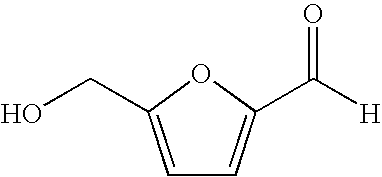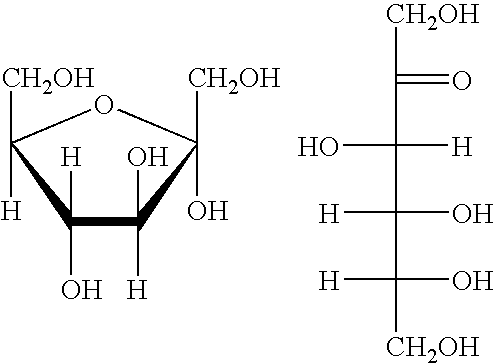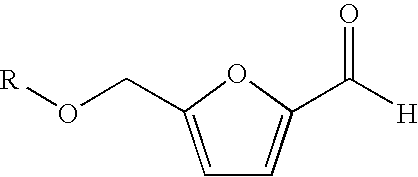Processes for the preparation and purification of hydroxymethylfuraldehyde and derivatives
a technology of hydroxymethylfuraldehyde and process, which is applied in the preparation of organic compounds, chemical apparatus and processes, and organic chemistry, etc. it can solve the problems of high cost, inability to use bf/sub>3/sub>et/sub>o as a catalyst, and high cost of hexos
- Summary
- Abstract
- Description
- Claims
- Application Information
AI Technical Summary
Benefits of technology
Problems solved by technology
Method used
Image
Examples
example 1
Preparation of HMF from High Fructose Corn Syrup at 115° C. in N-Methylpyrrolidinone (NMP)
[0072]A 250 mL 3-neck round bottom flask was fitted with a magnetic stir bar, heating mantle, reflux condenser, and temperature probe. To this flask was charged 100 mL of NMP (Aldrich) and 20 g of Amberlyst 35 resin (Rohm and Haas, Woodridge, Ill.). Amberlyst 35 is a macroreticular, strongly acidic, polymeric catalyst. The mixture was heated to 115° C., and 50 g of Cornsweet 90 (HFCS, ADM, Clinton Iowa) was added. Heating continued in this manner at 115° C. over a 5 hour period. Water condensed on the reflux condenser. After 5 hours, the contents of the flask were cooled to about 70° C., and the resin removed by vacuum filtration to provide a product isolate. The product isolate was analyzed to provide a solution of 14.2% HMF by weight and 4.7% fructose. Calculations indicate an 80.6% molar yield of HMF from fructose and 94.1% conversion.
example 2
Preparation of HMF from High Fructose Corn Syrup at 105° C. in NMP
[0073]This example illustrates the effect of temperature on the dehydration of fructose to HMF. A 250 mL 3-neck round bottom flask was fitted with a magnetic stir bar, heating mantle, reflux condenser, and temperature probe. To this flask was charged 100 mL of NMP (Aldrich) and 20 g of Amberlyst 35 resin (Rohm and Haas, Woodridge, Ill.). The mixture was allowed to heat to 105° C., and 50 g of Cornsweet 90 (HFCS, ADM, Clinton, Iowa) was added. Heating continued in this manner at 105° C. over a 5 hour period. Water condensed on the reflux condenser. After 5 hours, the contents of the flask were cooled to about 70° C., and the resin removed by vacuum filtration to provide a product isolate. The product isolate was analyzed to provide a solution of 12.9% HMF and 3.9% fructose. Calculations indicate a 71.6% molar yield of HMF from fructose and 85.4% conversion.
example 3
Preparation of HMF from High Fructose Corn Syrup at 105° C. in NMP Under Vacuum Conditions
[0074]This example illustrates the effect of distillation on the dehydration of fructose to HMF. A 250 mL 3-neck round bottom flask was fitted with a magnetic stir bar, heating mantle, condenser, temperature probe, and receiving flask. To this flask was charged 100 mL of NMP (Aldrich), 20 g of Amberlyst 35 resin (Rohm and Haas, Woodridge, Ill.), and 50 g of Cornsweet 90 syrup. The mixture was heated to 105° C. under house vacuum. The distillate was collected. After 2 hours, the contents of the flask were cooled to about 80° C., and the resin removed by vacuum filtration to provide a product isolate. The product isolate was analyzed to provide a solution of 14.2% HMF and 1.1% fructose. Calculations indicate a 75.7% molar yield of HMF from fructose and 79.5% conversion.
PUM
| Property | Measurement | Unit |
|---|---|---|
| temperature | aaaaa | aaaaa |
| temperature | aaaaa | aaaaa |
| time period | aaaaa | aaaaa |
Abstract
Description
Claims
Application Information
 Login to View More
Login to View More - R&D
- Intellectual Property
- Life Sciences
- Materials
- Tech Scout
- Unparalleled Data Quality
- Higher Quality Content
- 60% Fewer Hallucinations
Browse by: Latest US Patents, China's latest patents, Technical Efficacy Thesaurus, Application Domain, Technology Topic, Popular Technical Reports.
© 2025 PatSnap. All rights reserved.Legal|Privacy policy|Modern Slavery Act Transparency Statement|Sitemap|About US| Contact US: help@patsnap.com



